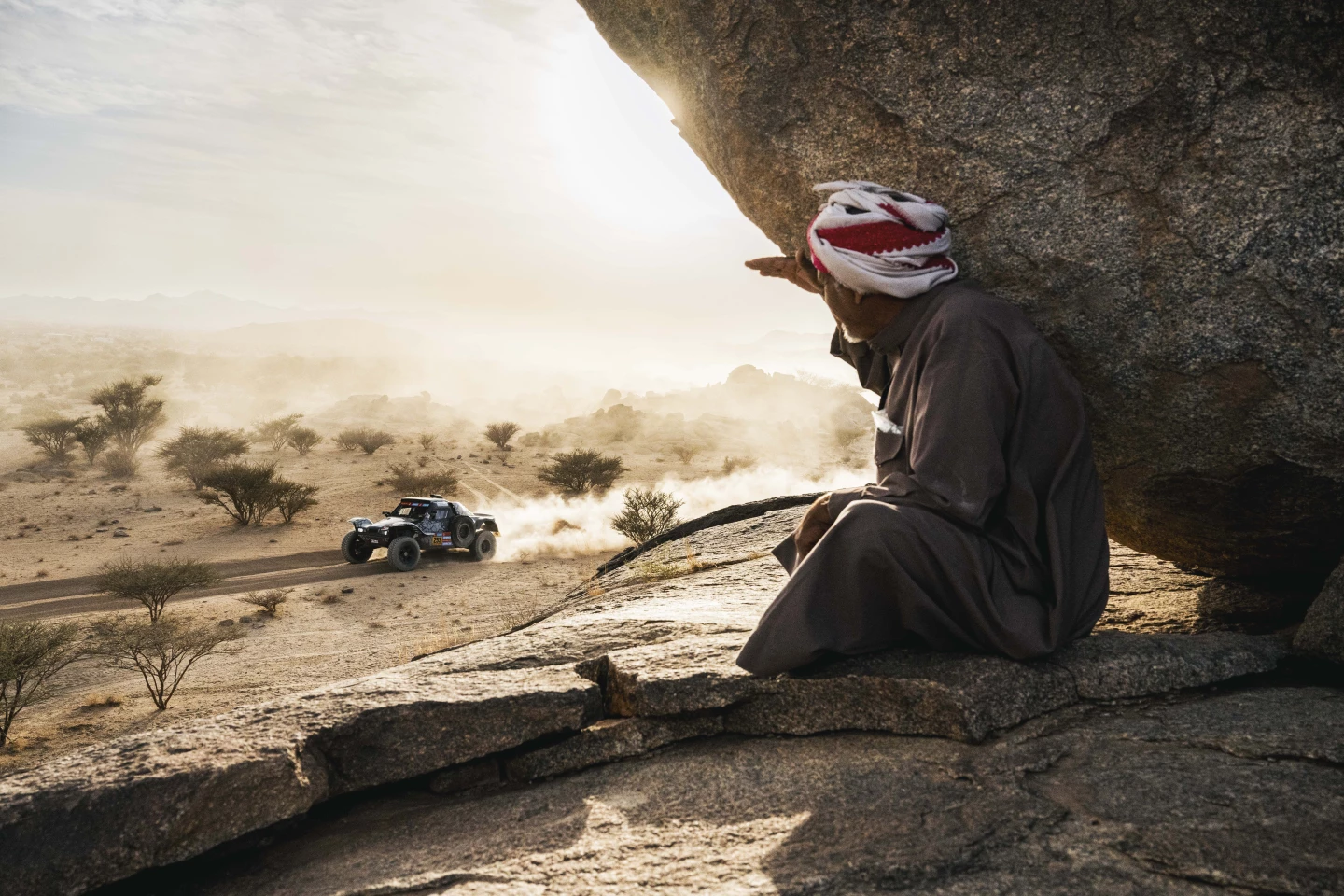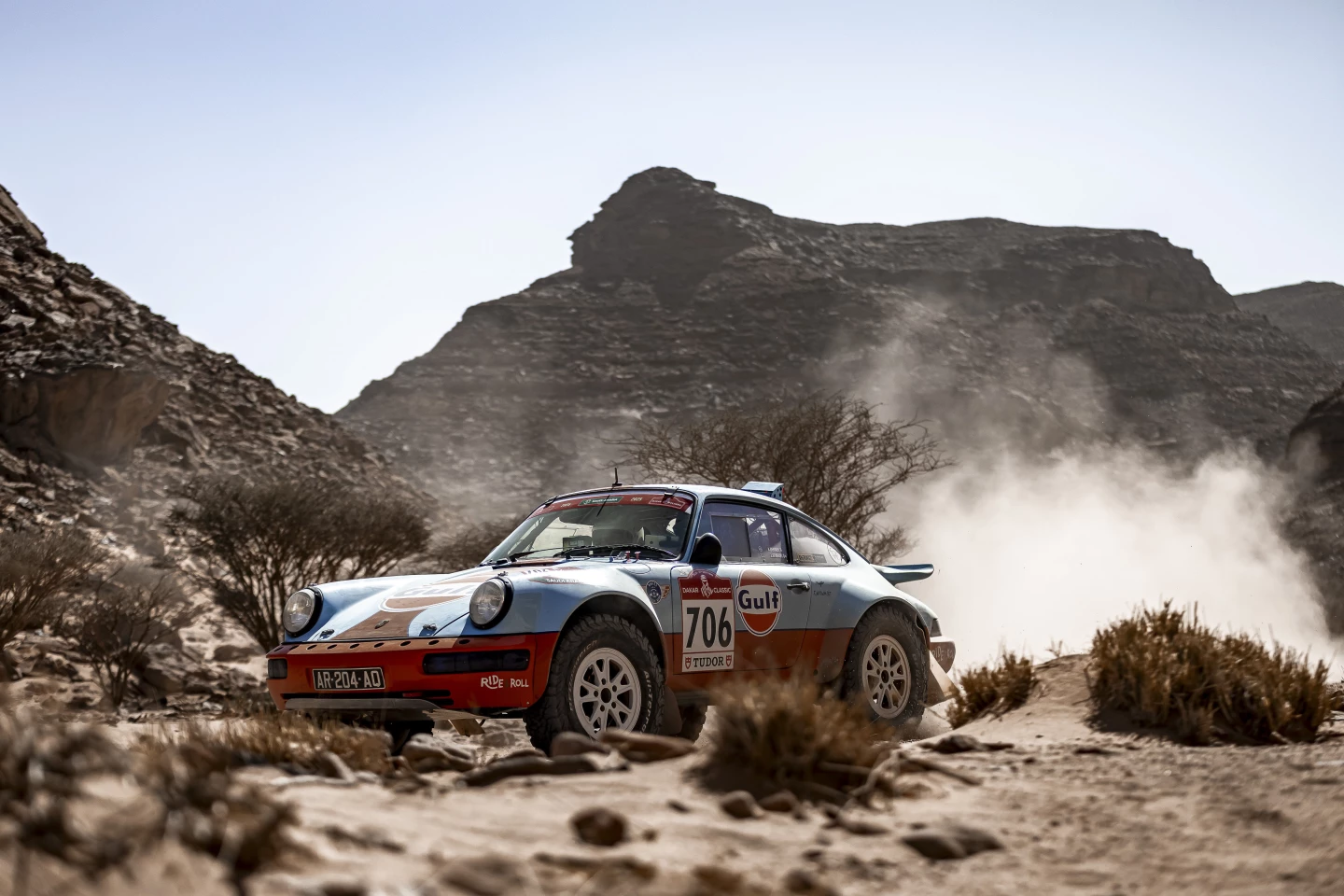Dakar Rally participants know what they're signing up for: a gruelling two-week ordeal they have no guarantee of completing. But this storied event was born of an even more extreme and dangerous experience, that one man had to endure all alone...
It was 1977 and Thierry Sabine was lost. He'd wandered the Libyan desert for three days in an ocean of featureless sand. His meager supplies – a few snacks and a bit of water – were gone.
January 14, 1977: the daytime temperatures weren't the scorching 100-plus-degrees you'd imagine from the deserts of Northern Africa. In fact, they were downright pleasant, hovering around 68 °F (20 °C). Perfect weather for blasting across the barren landscapes at break-neck speeds on the very best Yamaha had to offer at the time, a tricked-out XT500.
It was the nights. The bitter, nearly freezing nights were the hardest.
Wearing typical rally gear of the era – a lightweight jersey and dirt bike pants, riding boots, thin gloves and a helmet. Maybe knee and elbow pads and a chest/back protector ... none of which provide much insulation from the elements. After all, it's rally gear for racing across the desert on two wheels made to survive a possible unexpected cartwheel off the bike, not survival gear. And Thierry did, in fact, have a crash. His rally gear did its job, protecting him from injury.

The compass that he relied on for navigation, however, did not survive. The now-smashed compass did nothing to help him orient himself in the otherwise featureless faces of the dunes spreading as far as he could see in the Ténéré desert, a part of the Sahara Desert known as the "desert within a desert," due to its unrelenting harshness.
With no roads nearby to reference, maps become of little use. The first military GPS satellite wouldn't be launched for another year and it would be six years before civilians would even have access to it. Heck, it'd be a dozen years before the first commercial GPS receiver, the Magellan NAV 1000 would be invented.
No, Sabine had to use the sun and the stars to try and navigate. While he was a seasoned veteran of long-distance racing, he had no formal training in celestial navigation. And it showed. He was lost. Out of fuel, out of food and out of water.

His route was from West Africa's Côte d'Ivoire (Ivory Coast) to Nice, France in stages. Some of these desert stages were upwards of 1,000 miles (1,600 km) and Sabine and fellow competitors were expected to arrive safely at the end in around 30 or so hours.
After missing his checkpoint in the Dirku-Madama stage and having run out of fuel, Sabine abandoned his trusty steed and began his three-day march to nowhere in one of the most remote places on the planet with only his shadow for company ... sometimes. With little hope and no water, Sabine resorted to sucking on rocks he found to keep his mouth from getting dry.
Paper logs were kept by race officials of each racer as they crossed a checkpoint with their race number and time recorded. If a competitor failed to reach a checkpoint within a certain timeframe, red flags were raised.
One would imagine that Sabine was rethinking his choice of racing the Abidjan-Nice Rally. Instead, even while suffering the effects of despair, hunger, exposure, and dehydration, Sabine was struck by the beauty of the desert and was formulating a plan, if he ever made it out alive.
Given Sabine's extensive racing and rally raid experience having raced various events across Europe and Africa – even finishing 13th overall at the 24 Hours of Le Mans driving a Porsche 911 Carrera RS – race organizers became concerned and launched a coordinated search and rescue effort using helicopters.
It would be two nights and three days before Jean-Michel Sine – a pilot and rally organizer – would spot Sabine's tracks in the sand and makeshift cross built from stones Sabine had found, leading to the rescue of the Frenchman and saving him from certain death.
When he was found, Sabine was severely dehydrated but uninjured and inspired. Sabine later co-authored a book recounting his experience called Paris Dakar.

In it, he says, "I realize that my situation is uncomfortable, difficult. Two days later I have no compass or clock, which broke down in a fall while trying to find the lost route. It is now two days and two nights that I am lost in the desert, under a sun that begins to make me lose my mind. The total absence of shadow is an oppressive sensation, which engenders a feeling similar to that of claustrophobia. Then I decide to get away from my bike. In socks and sucking the stones to give me saliva, I realize my life is worthless and less. And that is when I promise that if I come out alive from this experience I will sweep away as much superficial as my existence contains."
And that plan he was formulating? After Thierry was rescued, he said, "The desert deeply marked me and developed in me a very particular instinct and sensitivity. And above all, insurmountable desires to return. But, since then, never again alone!"
Sabine's experience, while harrowing, was also inspiring to him. Thierry wanted to take the best parts of the rally while improving on the safety to create a new long-distance rally raid for others to take part in. He wanted everyone to experience the beauty of racing across the desert while putting themselves to the test.
His motto: "A challenge for those who go. A dream for those who stay behind." And he called it the Rallye Paris-Dakar.

The first Paris-Dakar Rally
On the day after Christmas in 1978, 170 competitors in cars, motorcycles and trucks left the starting line in Paris, France. It would become one of the most iconic and diverse races in the world, traversing 6,200 miles (10,000 km) through Europe, across the vast and unforgiving Sahara Desert in Northern Africa, before ending in West Africa. Dakar, Senegal, to be exact, on January 14, 1979. Of the 170 starters, only 74 competitors managed to cross the finish line – a testament to the difficulty of the rally. Since then, the race has only grown in numbers. In 1988, 603 vehicles competed.
Only once has the annual race been canceled. In the months leading up to the 2008 rally, local political instability coupled with a regional cell of Al-Qaeda actively terrorizing the country of Mauritania – one of the countries where the race was scheduled to traverse – led to the cancellation of the Paris Dakar rally for the first time just one day before the rally was scheduled to start.

This led to the Dakar rally relocating to South America for the next ten years, blasting through Argentina, Chile, Peru, Bolivia, and Paraguay before moving to Saudi Arabia in 2020. Not even Covid-19 stopped the race.
While the race no longer starts in Paris or ends in Dakar, the "Dakar" name remains the same. The iconic rally is rich in motorsports history. Tens of thousands of competitors from nearly 100 countries around the world have gotten together for the roughly two-week competition of true grit since its inception.
The 2025 Dakar Rally
This year marks the 47th edition of the Dakar, and the sixth year of racing exclusively in Saudi Arabia. The race is just shy of 5,000 miles (8,000 km) from Bisha to Shubaytah. The longest single stage is 514-miles (828-km) long. The racers and teams will camp in bivouacs (temporary tent encampments) throughout the entire 15-day rally, with only one day designated as a rest day.

Some 590 riders, drivers, and co-pilots from 52 countries are entered for this year's rally, with 439 vehicles in total.
It's one of the most grueling races on the planet, tackling seemingly endless expanses of sand. And when they're not plowing over 300-ft (90-m) dunes that can swallow vehicles whole, they're navigating over jagged, tire-destroying, bone-rattling rocks eager to break even the toughest equipment and spirits.
The class breakdown is pretty straightforward: Bikes, cars, trucks, lightweight vehicles, and Dakar Classic.
Bikes are separated as RallyGP (the big-dog pros), Rally2 (amateurs or semi-pro riders), and Original by Motul, formerly known as Malle Moto (the crazy riders that are soloing the entire race without any kind of assistance. There are 25 this year. "Malle" refers to the single trunk the competitor was allowed to have for all their personal items, parts, and tools).

The Cars class, which can resemble cars or trucks and have a driver and navigator, are T1 Ultimate (high-dollar prototype vehicles), T2 (production vehicles), and Open (any vehicle that conforms to SCORE International regulations, like the famous Baja 1000 race in Mexico). Many of the T1 Ultimate class has switched to electric drivetrains, hydrogen-powered, or hybrid engine systems.
The Truck class competes in the T4 category but are any heavy-duty four-or-six-wheeled vehicle that weighs a minimum of 7,716 lb (3,500 kg). Trucks have a driver, navigator, and mechanic. They're often referred to as the "angels of the desert," as they're the ones in the back of the pack, stopping to assist other teams, whether that means helping to turn a wrench, getting a vehicle unstuck, or providing extra supplies like parts, fuel, food, and water. Trucks exemplify the Dakar spirit of camaraderie and survival over just competition ... and it's really cool to see a 7,000+ lb truck flying through the air over a jump.

Lightweight vehicles are T3 (custom prototypes with a minimum weight of 1,984 lb/900 kg and up to 1,050cc engines) and T4, the explodingly popular side-by-side (SSV) class, also with a minimum weight of 1,984 lb.
Dakar Classic is a little different. Vehicles must be manufactured before 2005 and are production-based. They're competing on less extreme routes that parallel the main stages, however, they focus on "regularity" rather than trying to set a blistering pace across the desert to see who can get to the finish first. Racers are judged on being consistent and maintaining an average speed. In fact, time penalties are assessed if you go too fast. Or too slow. Classic is mostly a nostalgic aspect of Dakar, where you'll mostly see vehicles like Toyota Land Cruisers, Porsche 911s, and Land Rovers.

It's day four now. There are nine more days of competition. When it's over, we'll wrap up with a gallery of the very best stories and photos from the scores of Dakar photographers.
In the meantime, you can check out the daily highlights on the official Dakar YouTube channel. (Viewer discretion is advised, due to a very bloody nose seen at the start of this clip below.)
Source: Dakar













